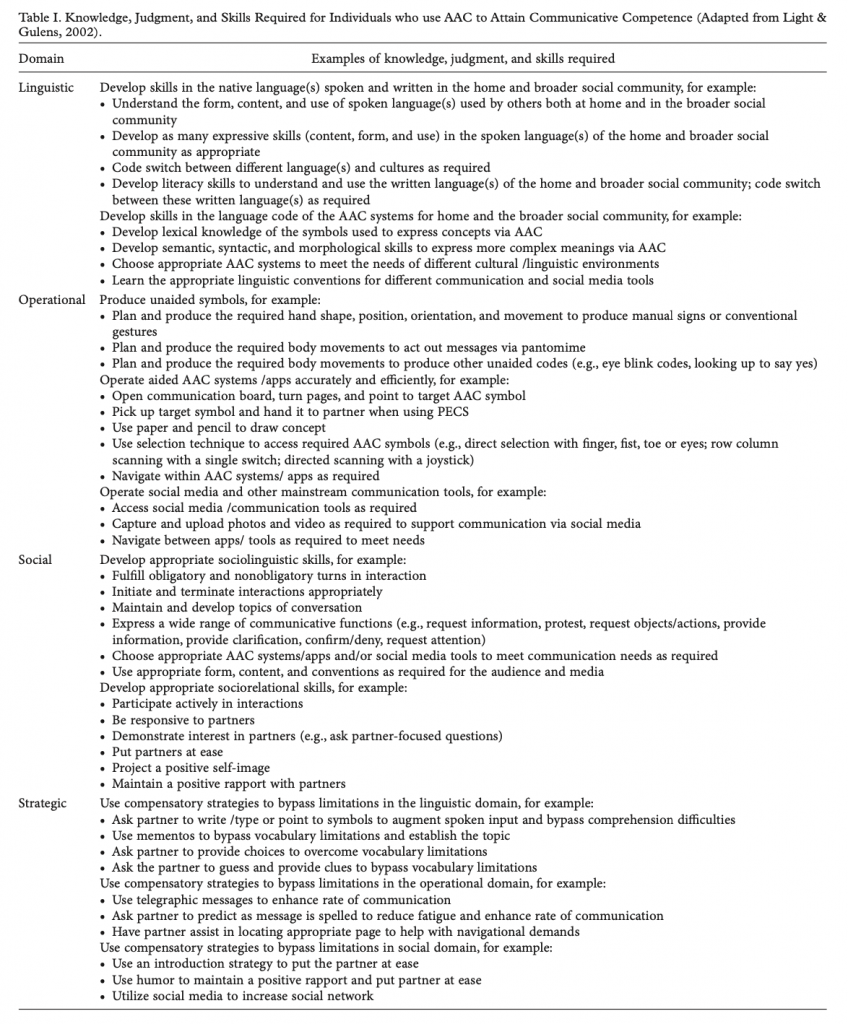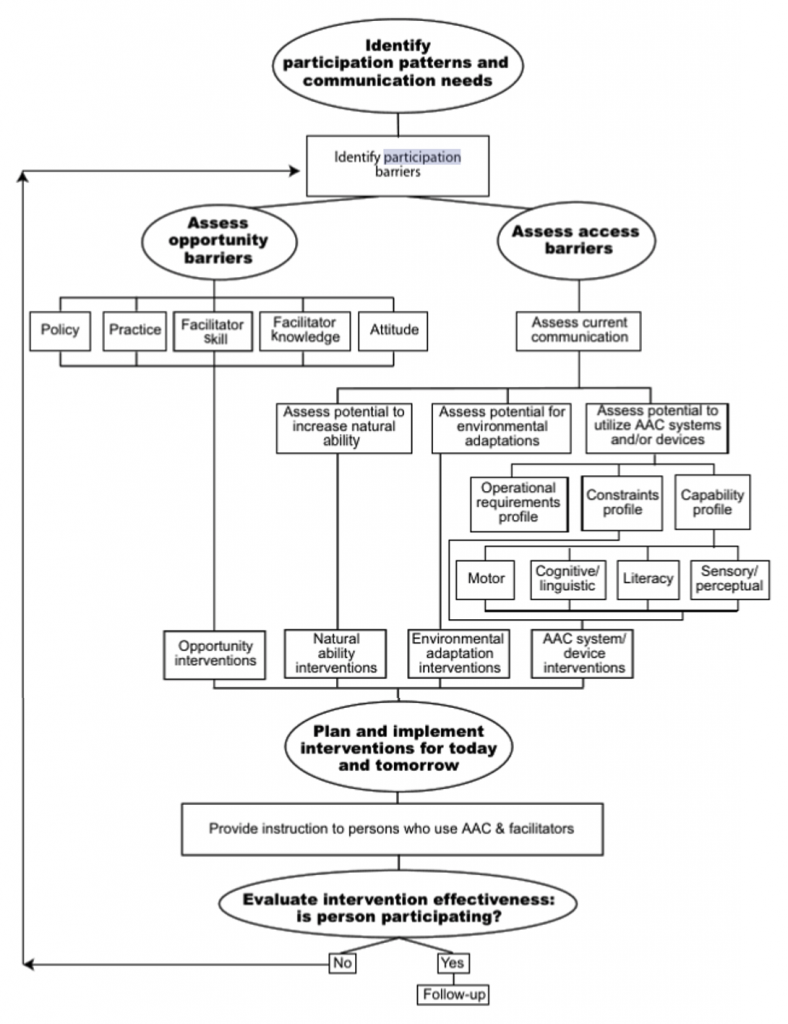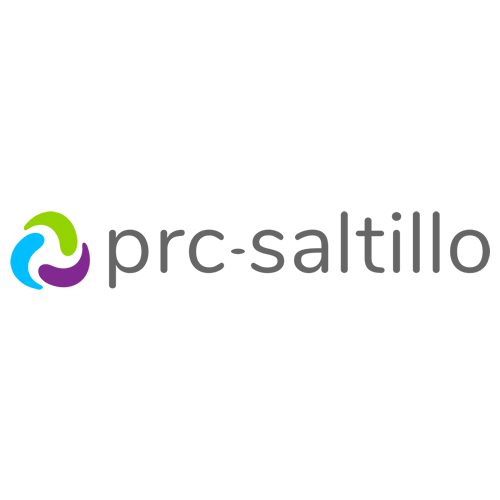Augmentative and Alternative Communication Interventions and Strategies

What is Augmentative and Alternative Communication (AAC)?
Augmentative and alternative communication (AAC) is a collection of strategies, tools, and gestures that can be used in place of speech that is not meeting the current communication needs of the environment.
AAC can be unaided or aided.
Unaided AAC are forms of AAC that can be done using only the body, such as sign language or gestures.
Aided AAC are forms of AAC that require the use of low, mid, or high tech adaptive technology.
Why Prioritize AAC Intervention?
Adults diagnosed with CP report that meaningful participation in daily routines is dependent upon communication, as opposed to independent mobility (Colver et al., 2013).
Physical gains of people with physical disabilities made during childhood can sometimes be lost as they age and disability progresses, which provides further evidence for prioritizing communication interventions (2013).
In addition, since the general curriculum can only be accessed through literacy and language, we must prioritize communication in order to help our students with complex communication needs access it (Beukelman & Mirenda, 2014).
Since communication and AAC intervention has been reported by people with physical disabilities, who also have communication concerns, to be the most important factor in meaningful participation, practitioners should put a special emphasis on providing appropriate intervention.
Who is Eligible for AAC Intervention?
25 years ago, AAC intervention was only available to students who had already achieved a number of prerequisite skills, which was known as the candidacy model (Beukelman & Mirenda, 2014).
The field of AAC intervention now posits that any skills required for AAC use can be taught through participation-focused outcomes and progress monitoring.
AAC intervention should be made available to any and all students whose current communication requirements are not being met using verbal language.
Common AAC Myths
| My student has not yet achieved the prerequisite skills to use AAC. | There are no prerequisite skills required to use AAC. AAC intervention will teach students the skills they need to effectively use AAC technology. |
| My student is not old enough to start using AAC. | The earlier students begin using AAC, the better the outcomes. Infants, toddlers, and preschoolers can all benefit from AAC instruction. |
| My student does not have adequate receptive language skills to begin using AAC. | Cognition and language support one another. The visual and auditory input provided by AAC can help to teach receptive as well as expressive language skills. |
| My student effectively has their needs met without language, and does not need AAC. | While students may be able to communicate wants and needs with gestures and vocalizations, AAC is necessary for nonverbal children to communicate about matters outside of their immediate context. |
| AAC will prevent my student from using verbal language. | Research indicates that AAC helps to increase verbal language, as it allows children to visualize language and provides auditory input. |
| My student will eventually be capable of using verbal language, and doesn’t need to use AAC. | AAC is not only for students who we know will not be capable of using verbal speech in the future. It can be a temporary solution to help meet the current communication needs of the environment. |
| My student does not have the cognitive skills to understand how to use AAC technology. | Again, cognition and language support one another! Even students with severe intellectual disabilities can learn to use AAC. They will learn words as communicative actions, as opposed to linguistic metaphors. |
| My student is not physically able to access AAC. | AAC does not require prerequisite skills, and it is the job of the teacher, speech therapist, and occupational therapist to help determine an access method that works for an individual student. |
What is the goal of AAC Intervention?
True participation in one’s environment requires AAC users to achieve communicative competence, or to have the necessary skills necessary to meet the communication demands of the environment (Light & McNaughton, 2014).
We should also be working towards communicative competence because it is necessary in order to help complex communicators access the general curriculum. Complex communicators will require access to linguistically robust AAC systems with consistent motor plans, in order to generate novel messages and to achieve communicative competence (Light & McNaughton, 2014).
In order for students to achieve communicative competence they must master skills in the areas of:
- Linguistic Competence;
- Operational Competence;
- Social Competence; and
- Strategic Competence
- Linguistic competence requires AAC users to learn the language of their environment, as well as the language of their AAC system (Light, 1989).
- Operational competence refers to the ability of AAC users to adequately operate their own device, encompassing skills such as being able to play and clear a message, being able to search, and being able to turn the device on/off (Light & McNaughton, 2014).
- Social competence necessitates knowledge, judgment, and skills in the area of pragmatics, such as when to speak, turn-taking, and what to talk about (Light, 1989).
- Strategic competence requires AAC users to possess skills that allow them to work around the limitations of AAC system, such as what to do if they are misunderstood or if they cannot find a particular word (Light & McNaughton, 2014).
The four competency areas are interrelated, are must be integrated in order to achieve communicative competence, and therefore increase participation in daily routines.

AAC Assessment
AAC intervention should always begin with dynamic assessment that considers the access and opportunity barriers that are preventing the student from participating in their environment (Beukelman & Mirenda, 2014).
Assessment should be done for the purposes of selecting an appropriate AAC device, develop the scope and sequence of intervention, and/or to modify an AAC system to better fit the current communication demands of the environment.
The Participation Model should be used to guide AAC intervention, which naturally means the assessor would need to start by assessing the target students’ participation.

Click here for more information on the participation model
When conducting AAC Assessment, practitioners should:
- Complete a participation inventory, which can be used to compare the target students’ participation to that of a student without disabilities. This can help to determine how effectively the target student is participating in their instructional, home, and community environments.
2. After determining whether or not the target student is effectively participating in their environment, practitioners must assess the access barriers and opportunity barriers that are inhibiting participation.
This information can further be used to plan and implement intervention goals and instruction.
Since AAC users will either be developing new competencies and increasing their participation levels, or may lose function due to progressing disability, practitioners must employ frequent progress monitoring.
Assessment Tools
Click below for access to AAC assessment tools:
- The Communication Matrix can be used to assess the forms and functions of communication, or the means of communication and the purposes of that communication. It can be used to assess students who are minimally verbal and who may be demonstrating little to no intentional communicative behaviors.
- The All About Me Inventory is a forms and functions checklist, that should be completed by families. This assessment tool can be used by professionals to gather information on the forms and functions of communication for children who are pre-linguistic or minimally verbal. The All About Me Inventory is a good tool to use with students who you are not familiar with, since families fill it out.
- The Dynamic AAC Goals Grid 2 (DAGG-2) can be used as a means to assess AAC users’ relevant skills in the areas of ability level, linguistic competence, operational competence, social competence, and strategic competence. Results from this assessment can then be used to determine the scope and sequence of intervention and instruction, as well as to develop goals, and monitor progress.
- The Augmentative and Alternative Communication (AAC) Profile was developed to assess skills of AAC users in the areas of operational competence, linguistic competence, social competence, and strategic competence. Using the AAC profile you can easily develop goals using the sequentially laid out skills in the four competency areas, and monitor the progress made towards those goals.
- The Tool for Analysis of Language and Communication (TALC) is an adapted language sample analysis tool, that can be used with children who are minimally verbal. This assessment tool that can be used to take total communication language samples with a means for analyzing modes of communication, the quantity of communication attempts, the successfulness of those attempts, the type of utterance, type of prompt, the purpose of communication, and the relationship of the communication partner.
- The Communication Sampling and Analysis (CSA) Assessment can be used with minimally verbal children to monitor communicative behaviors within natural settings. It can further be used to create a communication inventory, as well as to create goals for unaided and aided communication.
Intervention
In order for students to achieve communicative competence, they must have access to AAC devices that have a clear motor plan, the ability to combine single words, provide core vocabulary, have the ability to search, contain morphological syntactical markers, and the have capacity for growth (Beukelman & Mirenda, 2014).
- A step-by-step switch may create the illusion of inclusion and participation, but cannot generate novel language and therefore cannot be used to build communicative competence.
AAC intervention for students with physical disabilities can require input from a team of individuals, including occupational and physical therapists, orthotics specialists, and rehabilitation engineers.
AAC intervention for students with OI must balance instructing the student in the motor plan and access methods, speech therapy, and academic instruction, according to individual needs.
Intervention should utilize total communication, or communication via multiple modalities, according to the demands of the environment and the preferences of the student.
The team should pay special consideration to the positioning of the student and the device, in order to minimize motoric demands and maximize participation.
Steps to AAC Intervention
- Identify contexts where AAC intervention will be meaningful. This should take child preferences and developmental levels into consideration. Activities should be highly motivating and teachers should strive to find the joy in communication.
- Provide a communication method for students. This can be in the form of communication boards, sign language or a speech generating device. Communication methods should be robust, linguistically organized, have a consistent motor plan, and should have the ability to generate novel messages (no step-by-step switches!).
- Select target vocabulary. Target vocabulary should consist of core words, and to a lesser extent, fringe vocabulary. Click here for a list of Gail VanTatenhove’s Common Words when deciding on which vocabulary to target.
- Arrange the environment for optimal communication. Make sure the student can easily access materials for the activity, as well as the AAC device. They should also be positioned for optimal social interaction with the communication partner.
- Implement appropriate intervention strategies to scaffold communication. Plan appropriate intervention strategies to help teach AAC and language skills (Light & Drager, 2019).
Intervention Strategies
Consider these intervention strategies when implementing AAC intervention:
Strategies that guide communication behaviors:
- Aided language input involves modeling AAC for AAC users. When implementing AAC intervention practitioners should use the device to communicate with students. Click here for more information on aided language input. Click here for a free PRC-Saltillo training on using aided language input!
- Least-to-most prompting involves beginning with less invasive prompts such as gestural prompts, and gradually moving to more invasive prompts such as physical prompting. Click here for a description of prompts and click here for a graphic of least-to-most prompting hierarchy.
- Using visual aids including pictures, photos, 3D objects, or partial objects. Academic instruction is often presented through text or verbalization, which may not be accessible for students with OI (Soto & Zangari, 2009). Click here for more information on using visual aids.
- Offer two choices to students and encourage them to make a choice. The choices can be items or activities, and should be motivating. An example could be a teacher showing the student bubbles and a story and asking “Do you want to blow bubbles or read a story?”
- Make high-probability requests, which are requests that are motivating and that the student is very likely to respond to. After making 3-5 high-probability requests, educators can try targeting low-probability requests.
Strategies for responding to and reinforcing communication behaviors:
- Use natural consequences to reinforce language use, in the form of nonverbal or verbal cues. An example of using nonverbal cues as a natural consequence could be in the form of a teacher blowing bubbles in response to a student saying “bubbles”. An example of using verbal cues as a natural consequence could be in the form of the teacher responding “I like this activity too!” in response to a student communicating “I like this”.
- Expansion involves repeating a student’s message while adding additional or new information. An example of this could be a student saying “bubble water” and the teacher responding “Yes, we put the bubbles in the water.” Click here for more information on using expansions in AAC intervention.
- Extension involves the educator changing the meaning of a student’s message by adding additional or new information. An example of this could be a student saying “sand play box” and the teacher responding “Yes, the sand is in the play box and the sand toys are in the play box too.” Click here for more information on using extensions in AAC intervention.
Strategies to create opportunities for communication:
- Ask open-ended/wh- questions to create opportunities for students to communicate using AAC. An example of this could be the teacher asking “What do we need to eat our lunch?”
- An expectant delay/time delay involves the teacher pausing for an extended amount of time, possibly while also making an expectant facial expression. This strategy can be used to create an opportunity for students to communicate using AAC. An example of this could be the educator asking a question then sitting silently with their eyebrows raised.
- A blocked response/interrupted behavior chain takes place when the student cannot complete or engage in an activity, or when an item necessary to complete the activity is taken away or out of sight (Soto & Zangari, 2009). An example could be giving the student their yogurt, but “forgetting” the spoon.
For more AAC Intervention Strategies click here.
Planning AAC Instruction
The AAC Language Lab site provides lesson plans and activities for AAC users of all levels. Some lessons are available for free, pay for a subscription to access all lesson plans/activities.
PrAACticalAAC provides AAC intervention strategies, as well as preplanned lesson plans for AAC users. Click here to access their year of core words lesson plans.
Click here for an example of a Curriculum-Based Activity Plan
Click here for an example of a Literacy-Based Activity Plan
Access Methods for Students with OI

Individuals that need to access AAC via alternative methods, such as eye tracking, a head mouse, or switch scanning, may require extensive motor training in order to learn to operate their device.
Investing in these labor-intensive methods can help with the long-term efficiency of communication, although this may be at the cost of short-term gains.
Intervention should ultimately aim to help students’ meet the communication needs of the immediate environment, while also investing in the future by using motor or speech therapy to learn more difficult skills.
Goal Planning
AAC goals should address the areas of linguistic, operational, social, and strategic competencies.
Goals should be determined off of assessment results and participation-based.
Long-term goals should be accompanied by smaller learning objectives, made up of the skills that are required to attain the long-term goal.
- Avoid short-term objectives that descending prompt levels or ascending successfulness levels. For example:
| Incorrect | Incorrect | Correct | |
| Long-Term Goal | By the next Annual Review, Student will independently use total communication (SGD, signs, or utterances) to participate in preferred activities by requesting more action, requesting a new action, or ending the activity by saying “all done”, in 4 out of 5 opportunities over a 3-week period, as measured by teacher observation. | By the next Annual Review, Student will independently use total communication (SGD, signs, or utterances) to participate in preferred activities by requesting more action, requesting a new action, or ending the activity by saying “all done”, in 4 out of 5 opportunities over a 3-week period, as measured by teacher observation. | By the next Annual Review, Student will independently use total communication (SGD, signs, or utterances) to participate in preferred activities by requesting more action, requesting a new action, or ending the activity by saying “all done”, in 4 out of 5 opportunities over a 3-week period, as measured by teacher observation. |
| Short-Term Objectives | 1. Student will use total communication to participate in preferred activities with a physical prompt 2. Student will use total communication to participate in preferred activities with a verbal prompt 3. Student will use total communication to participate in a preferred activity with a non-verbal prompt | 1. Student will use total communication to participate in preferred activities in 1 out of 5 opportunities 2. Student will use total communication to participate in preferred activities in 2 out of 5 opportunities 3. Student will use total communication to participate in preferred activities in 3 out of 5 opportunities | 1. Student will request more action using total communication 2. Student will request a new action using total communication 3. Student will use total communication to end activities by saying “all done” |
Resources for Teachers

PRC-Saltillo offers many free online trainings regarding AAC. Click here to access free online trainings.
Liberator additionally offers free trainings in AAC use and intervention. Click here to access these trainings.

